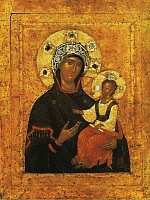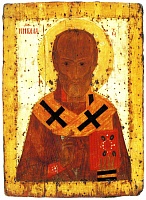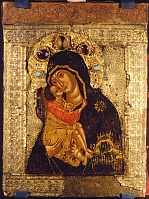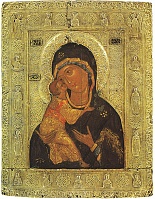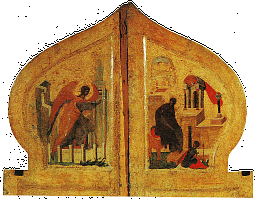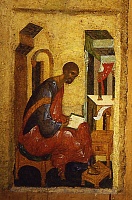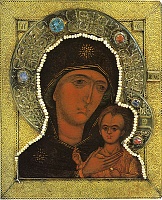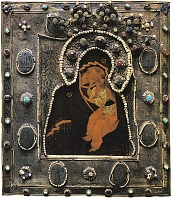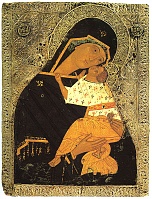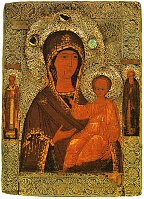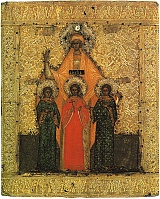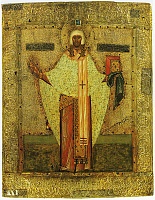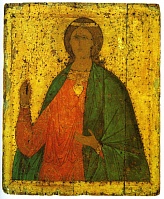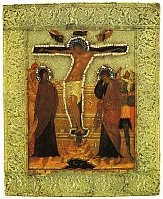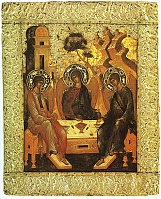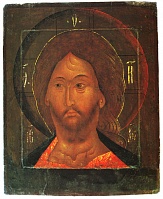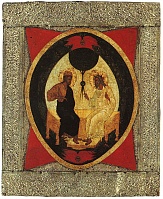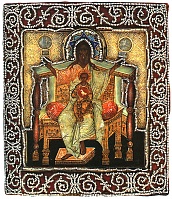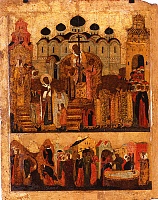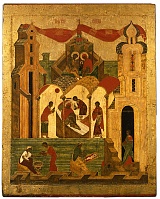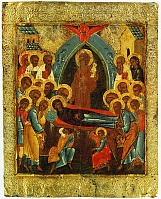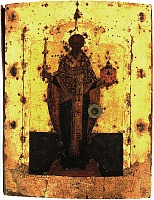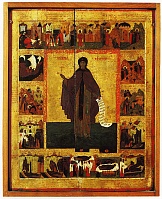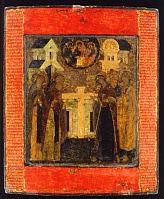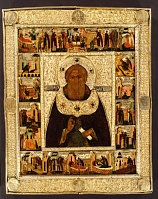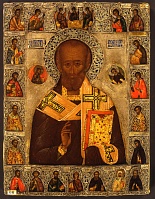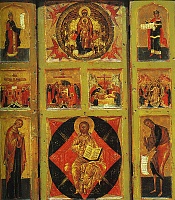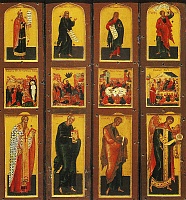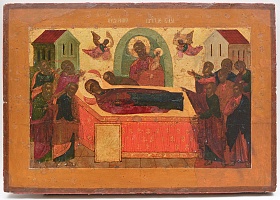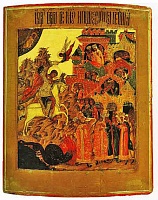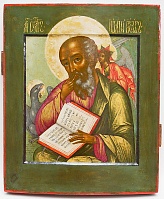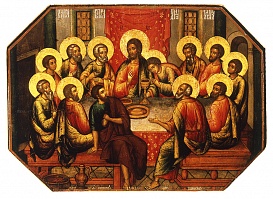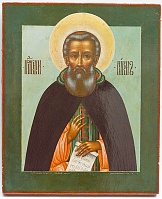Icons of the 14th – 17th cc.
Icon painting justly occupies an outstanding place in Old Russian art. It is “a real manifestation of spiritual life of the whole nation”. The Museum collection of icons includes different schools and original iconographies. You can see here rare monuments of the 14th century, works of Andrei Rublev circle and its successors, various specimens of the 16th century, icons of Stroganov and Godunov painters of the early 17th century and icons of the tsar isographert of the second half of the 17th century – Simon Ushakov.
Small prayer icons with the image of the Virgin in various iconographies constitute a considerable part of the collection. The most widespread images: the Virgin Hodigitria, the Virgin Eleousa, the Virgin of Tikhvin, the Virgin of Kazan, etc. – were usually family relics of Moscow princes and boyars, donated or brought on the coffins and left in memory of the people buried in the Monastery, according to the old tradition. Numerous icons with the image of the Virgin demonstrate great skill in expressing various shades of feelings even within the limits of the same iconography.
The earliest specimens date back to the second half of the 14th century. Originating from different places, they demonstrate artistic interests of the Moscow principality. At that time Moscow was well acquainted with ancient traditions of South Slavonic countries, Byzantium and Old Russian centers. “St. Anna with the Child Mary” demonstrates identity with Serbian icons of the 14th century in its unusual iconography, manner of painting and color scheme. This icon is connected with Voyeyko Voytegovich, a son of the Serbian nobleman. “The Virgin Perivleptos” reminds of close relations between Russia and Byzantium. Its Constantinople origin was recorded in the Monastery documents. The icon was believed to have been painted by Ignatius the Greek who was commissioned by Prince Yury Dmitriyevich of Zvenigorod, the son of Dmitry Donskoi. “St. Nicholas of Myra Lycia” called “St. Nicholas” in Russia was the cell icon of the Monastery founder Sergius of Radonezh. It shows characteristic features of Rostov icon-painting. ( Now the icon is in the Trinity-St. Sergius Lavra).
Мoscow art at the turn of the 15th c. was brilliantly reflected in Andrei Rublev works. Andrei Rublev’s name was inseparably connected with the Trinity-St. Sergius Monastery. Here his youth passed, and here he most probably took monastic vows. He painted “The Trinity of Old Testament” (State Tretyakov Gallery) in praise of Sergius of Radonezh. His team painted icons for the iconostasis of the Trinity Cathedral, constructed above the tomb of Venerable Sergius. The iconostasis is a picturesque ensemble which has survived in the interior for which it was created.
The Museum displays the Royal Doors from the Trinity Cathedral. The simple reasoned composition, soft, echoing lines, expressive silhouettes, gentle color scheme testify to a great talent of the unknown artist of Rublev school. The Evangelists are reserved and absorbed in spiritual thoughts.
Andrei Rublev’s art greatly influenced the subsequent development of Old Russian painting. The 15th century was the time of brilliant flowering of art when Andrei Rublev heritage was creatively estimated. The icons, depicting the Virgin, present a kind of gallery of beautiful female images. Christian legends used to associate the Virgin with all features of female beauty. But external beauty always implied inner moral beauty. That is why Old Russian icon-painters did not just visualize the most attractive national features, they conveyed the highest spiritual qualities of a person.
The image of Mary in the icon of Princess Neonila of Rostov is fragile and refined. The small icon with the images of SS. Sophia, Vera, Nadezhda and Lyubov is marked with fine silhouettes, simple composition and decorative color scheme. The icon “St. Leontius of Rostov depicts the 12th century ascetic famous for hard Christian mission in pagan Rostov. The light colors of St. Leontius’s vestment with prevailing shades of white and blue, glittering gold and precious stones correspond to austere and somewhat reserved image.
The icons of the late 15th – early 17th century form an interesting group. They preserve inner expressiveness and spiritual content of the first half of the 15th century, yet they are marked by new features approximating them with icons, painted by Dyonisius, which constituted the main Moscow artistic trend of that time. The works of Dyonisius circle are characterized by elegant forms, elongated proportions, refined color scale. The icon “St. Barbara” from the Church of Intercession of Volokolamsk is a fine specimen of that style. “The Crucifixion” and companion “Old Testament Trinity” were probably influenced by Dyonisius’s art.
Moscow art occupied a leading place in the 16th century Russian State. Icon-painting preserved the high artistic level of the previous time, but the content was different. The 16th century was the time of considerable changes in Russian political, economical and cultural life connected with the reforms of Tsar Ivan the Terrible (1533 – 1584). Everything was strictly regulated, exemplums were to be necessarily observed.
At that time the image of Christ Pantocrator was widespread. The Museum icon shows rare individualizes features: an elongated oval face, piercing glance, highly elevated brows a large aquiline bent down nose. “The New Testament Trinity” and its iconographic variant “Fatherland” are interesting monuments of that epoch.
In the 16th century multifigured compositions were very popular. “The Exaltation of the Cross” is a characteristic work of that time. The icon originated from the wooden church of Vozdvizhenskoye village, situated not far from the Monastery on the ancient pilgrimage route of Moscow tsars. The small icon “The Nativity of the Virgin” belongs to the same multifigured type. “The Assumption of the Virgin”, probably painted by a Tver artist, is rather narrative and illustrative, corresponding to the 16th century Russian icon-painting. This icon originated from the Church of Intercession of Volokolamsk. Previously it used to belong to the Assumption Cathedral of St. Barbara Monastery.
Формальные качества древнерусской живописи XVI в. во многих произведениях очень высоки, а порой и совершенны. Превосходно написаны две иконы - "Никола" и "Иоанн Предтеча - ангел пустыни", являвшиеся, видимо, некогда створками какого-то киота. В XVII в. они находились в иконостасе Троицкого собора.
“St. Nicholas of Mozhaisk” is another interesting work.. The great popularity of St. Nicholas in Russia resulted in development of purely Russian iconographies of this Byzantine saint. A legend of a miraculous salvation of Mozhaisk from tartars, when St. Nicholas appeared to the inhabitants with a sword and a town in his hands, was a basis for the image of St. Nicholas of Mozhaisk. A considerable group of icons, painted by the local Trinity artists, is significant in the 16th century collection. The earliest icon in this group is “St. Xenia and the Scenes from Her Life”, painted by an undoubtedly talented artist.
David Syrakh was presumably a Trinity icon-painter. His name is written on the icon “The Virgin of Vladimir”, painted in 1571. Interesting Trinity icons of the last decade of the 16th century are connected with the Monastery cellarer Eustathius Golovkin. He was the Monastery cellarer in 1571 – 1581 and in 1583 – 1593. A person of great organizing ability and authority, he was highly respected by Russian tsars and took part in political life of the country.
In 1588 Eustathius Golovkin has written "The Appearance of the Virgin to St. Sergius of Radonezh " - the central part of a known triptych, on which narrow shutters are represented (probably, other artist) outside - John Baptist and St.Nicholas, inside - archangel Michael and the Guardian angel. The "St. Sergius of Radonezh and the Scenes from His Life" (the other work of art) Eustathius Golovkin has written three years later, in 1591. The Sample for it was the similar image of the end XV - the beginnings of XVI century from an iconostasis of the Troitsk cathedral. Most likely, the icon "St. Nicholas with the Trinity and the elite sacred" has written by the Troitsk master
In Moscow icon-painting of the late 16th – early 17th century there were two prominent trends conventionally called “Godunov” and “Stroganov” painting. The names were the more conventional, when the same icon-painters were commissioned by the Godunovs, Stroganovs and Romanovs. The hinged sections of the icon-case for the icon by Andrei Rublev “The Trinity of Old Testament” were commissioned by Boris Godunov in 1601. There are four high, narrow panels connected by pairs. In twenty fragments the Bible story of the “deeds” of the Holy Trinity are depicted in a vivid, amusing and narrative manner.
One of the best examples of “Stroganov” painting in the Museum collection is the folding iconostasis donated to the Trinity Monastery in memory of Duma deacon Ivan Tarasievich Gramotin. Painted on twenty eight narrow panels, each separated in three parts, the folding iconostasis presents a miniature iconostasis with three classic ranges: Deesis, Festivities and Prophets.
The 17th century Russian art is varied in themes and stylistic trends. It reflects a great tension of spiritual life caused by the events that took place at the beginning of the century: dynastic crisis, peasant movements, national struggle for liberation. Gradually and slowly, in bitter disputes the world view was changing and new conception of an individual’s role was taking shape.
In the 1660s Simon Ushakov became a tsar isographer and a leading painter of the Armoury Chamber. His art determined quite an epoch in Russian art. In the course of 22 years he supervised icon-painting in the Armory Chamber. He was a very industrious man of great executive talent and other remarkable abilities. Apart from icons Simon Ushakov painted murals in churches and palaces, made engravings, portraits, wrote treatises on art, made drawings for embroideries, banners and coins. Creative works of the outstanding imperial icon-painter is present in collections of the museum by interesting art monuments of 70-80th years of the XVII century.
Distinctive feature of icons of Simon Ushakov, which is in the collection of the museum, - presence on them of author's signatures. In 1671 B.M. Khitrovo inserted into the Troitsk monastery the small icon "The Assumption of the Virgin". More interesting praying icons, created by Simon Ushakov in 1673. To them concern "John Theologian" and "St.Nikon Radonezhsky". One of the last works of Simon Ushakov in the Troitsk monastery - the icon "The Last Supper", created by him in 1685 for the Uspensky cathedral. Skill of the mature artist showed in full measure here.









